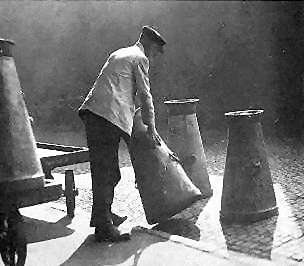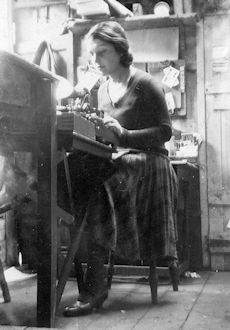
My Family History
Leonard Ball - the Artist
Click here for the My Family History main page.

The Early Days
My Dad, Leonard Ball, first showed his artistic potential while at school. He then developed his talents further at Day and Evening Classes at Handsworth Technical School's School of Art. In the summer of 1911, when he was 14 years old, he was awarded a first class certificate in Brush Drawing.
He obtained his first job in Birmingham's famous Jewellery Quarter, working for a firm that made stained glass windows. At the same time, he began to develop an interest in commercial art.
By 1913, when he was 16 years old, he was working from an address in Soho Road, Handsworth, designing and producing posters and tickets for local churches and other organisations. A surviving sketch book from this period also includes examples of fashion designs.
Right: One of Dad's original pen-and-ink fashion sketches
signed "F. Ball" and dated July 11th, 1914, when he was 17.
The Great War Intervenes
Dad was 17 when the Great War began in August 1914. He continued at work for a while, but was conscripted into the Army in June 1916. This called a temporary halt to his ambitions in commercial art! Dad's wartime experiences are described on a separate web page.
The Post-War Period
After Dad returned from the war in early 1919, he decided to strike out on his own in the world of commercial art. He also did some painting for his own enjoyment, including paintings in watercolours and in oils of Ezra's tomb – one of the sights he'd seen in Mesopotamia (now Iraq) during the war. But times were difficult, and  Dad managed to make only a meagre living doing posters, tickets, signs and shop window displays.
Dad managed to make only a meagre living doing posters, tickets, signs and shop window displays.
Left: Dad working on a shop window display in the 1930s.
Though there were plenty of jobs in Dad's line of work, he wanted to be his own boss. Unfortunately, he had no head for business and didn't charge enough for his work. He couldn't afford to buy his materials in bulk, and had no choice but to pay the more expensive retail prices for them.

Above: Grandpa Ball working as a porter at New Street Station, Birmingham in the 1920s. |
Dad still lived at home in Holliday Road, Handsworth with his parents and his younger sister Alice. His father (my grandpa) worked as a self-employed porter at New Street L.M.S. railway station, and his mother (my grandma) worked at home, so there was little money in the family.
 By now, Dad was very friendly with Mona Neale, the girl whom he would eventually marry. In the late 1920s, he rented a first-floor studio above a solicitor's and estate agent's office on the Soho Road in Handsworth, and he asked Mona if she would help with the book-keeping and some general office work. She agreed to help out at weekends, but soon she was working for Dad full time (see right).
By now, Dad was very friendly with Mona Neale, the girl whom he would eventually marry. In the late 1920s, he rented a first-floor studio above a solicitor's and estate agent's office on the Soho Road in Handsworth, and he asked Mona if she would help with the book-keeping and some general office work. She agreed to help out at weekends, but soon she was working for Dad full time (see right).
 Meanwhile, in the early 1930s, Dad moved to different premises in Waverhill Road, just off the Soho Road (see business card, right). Meanwhile, in the early 1930s, Dad moved to different premises in Waverhill Road, just off the Soho Road (see business card, right).
Changing Priorities
By 1939, with the Second World War imminent, Dad was supplementing his income by helping out part time at The Scout Shop in Dale End. In April of that year, Mom (36) and Dad (now 42) got married, and in June 1940 their first baby (me!!) was born. Realising the income from his business would not be enough to support his wife and family, Dad abandoned the commercial art business and started full time work as a clerk in Joseph Lucas Ltd's Great King Street factory. Lucas's were manufacturing aircraft instruments as part of the war effort.
From this point onwards in Dad's life, commercial art became only an occasional activity. After the War, he continued to do the odd sign-writing job for the local church and for a few of his former shop-owner customers. Most of this work was done at ridiculously cheap rates and he barely covered his costs. He also produced a number of elaborately worked illuminated addresses and testimonials mainly for the Boy Scouts Association. He rarely charged for such items, even though they involved very delicate and time-consuming work.
In the late 1950s, because of failing health, Dad's hands were no longer steady enough for him to continue with his craft. His artistic talents had been largely wasted. However, his skills seem to have been inherited by his grandson (my son) Dave whom he never lived to see, and who is ensuring the name Ball becomes well-known in the world of art!!
Continue to next page
Back to Frank Leonard Ball menu page
|


 By now, Dad was very friendly with Mona Neale, the girl whom he would eventually marry. In the late 1920s, he rented a first-floor studio above a solicitor's and estate agent's office on the Soho Road in Handsworth, and he asked Mona if she would help with the book-keeping and some general office work. She agreed to help out at weekends, but soon she was working for Dad full time (see right).
By now, Dad was very friendly with Mona Neale, the girl whom he would eventually marry. In the late 1920s, he rented a first-floor studio above a solicitor's and estate agent's office on the Soho Road in Handsworth, and he asked Mona if she would help with the book-keeping and some general office work. She agreed to help out at weekends, but soon she was working for Dad full time (see right). Meanwhile, in the early 1930s, Dad moved to different premises in Waverhill Road, just off the Soho Road (see business card, right).
Meanwhile, in the early 1930s, Dad moved to different premises in Waverhill Road, just off the Soho Road (see business card, right).
 Dad managed to make only a meagre living doing posters, tickets, signs and shop window displays.
Dad managed to make only a meagre living doing posters, tickets, signs and shop window displays.